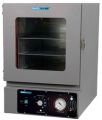A Simple Guide to Laboratory Vacuum Ovens and Safety Tips to Remember

Laboratory vacuum ovens are an absolute necessity in any laboratory environment and are used for a variety of purposes, depending on the type of oven. However, due to their high level of power and the risk that comes with working close to hot surfaces, when not properly instructed in their operation or safety precautions it is possible for accidents to occur. That’s why we’ve put together this list with helpful tips and guidance on laboratory vacuum ovens and safety measures you should remember at all times.
How Vacuum Ovens Work?
Vacuum ovens work by utilizing a plasma arc chamber to heat an electrically conductive surface to a high temperature. This allows the oven to achieve extreme temperature levels and high temperatures in a very short time frame, which is key in the testing of certain products, as well as materials.
Depending on the type of oven, they are either used for direct sterilisation or drying purposes. The type of chamber used in vacuum ovens also depends on their use. The more traditional lab vacuum ovens have a low voltage power source of around 1Volt per inch (V/in).
Uses of Vacuum Ovens
This type of oven is very useful for materials such as paper, ceramics, glass, rubber and plastics. Meanwhile, the other type of laboratory vacuum oven utilises higher voltage power sources of up to 40v/in to achieve faster processing times.
Vacuum ovens are very versatile in their use and can be used to heat virtually any material including steel and medical equipment. However, they usually fall short when attempting to dry biological samples or biological cells as they tend to dry out before reaching the desired temperature.
Some Safety Tips For Using Vacuum Ovens
Following the safety tips below will keep you on the right track while using the vacuum oven.
ü The first step is to make sure that you know what temperature your product will reach and how long it will take to reach that temperature.
ü Next, ensure that your work area is clean and free of any harmful elements and hazardous chemicals.
ü Another important thing to keep in mind is that it is not only the heat produced by the oven that can be dangerous but also spent electrode produced from parts of the oven. This can cause serious burns, especially if your hands are close to the hot surface.
ü Always remember that working with vacuum ovens requires a lot of caution and vigilance, as you can be subjected to burns due to the high power levels used in these ovens.
Using a vacuum oven safely, is something that cannot be achieved by simply reading through one or two guides and then going head first into the project. Rather, it needs careful planning and a lot of patience in order to avoid any mishaps while working with this type of technology.
Original Link: https://theomnibuzz.com/a-simple-guide-to-laboratory-vacuum-ovens-and-safety-tips-to-remember/
Other articles and publications:
- +1 (714) 754-6660
- 2106 N Glassell St, Orange, CA, 92865, USA
- www.globallabsupply.com/Chairs-Stools-s/1825.htm



